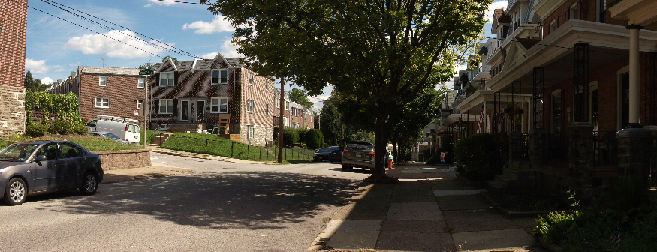 |
| Fig 1. Here we see Kansas City's essential commuter rail problem: the rail axis (red) is essentially orthogonal to the urban axis (black). The red and the black. Heh. |
While a challenge, this is not an insurmountable problem. Union Station is adjacent to two major districts in its own right, and skillful connection-making with the Main Street corridor -- which is the urban axis, and one that desperately needs light rail -- allows for the distribution pattern, north to downtown and the River Market, and south to Westport, Country Club Plaza, and Brookside, needed to tie the regional system in with the urban system.
It is notable that the Market-Frankford Line (the El), Broad Street Line (subway), and Subway-Surface Lines (trolleys) have similar roles in Philadelphia; our major urban playgrounds -- Fishtown/Northern Liberties, Old City, Passyunk Square, Fairmount, and University City -- are about as far afield of each other as they are of Center City proper. We often come in on Regional Rail and transfer to these other modes.*
 |
| Fig 2. Here we see the lack of routes to KCI. A potential alignment (black) is given. |
 |
| Fig 3. Rail v. highway alignments in eastern Kansas City. Note how rail will be hard-pressed to compete on any sort of time advantage. |
On the coasts, we often find that riders are willing to sacrifice a certain percentage of their time for the luxury of not having to drive^. Even so, we find that commuters shy away from commutes lasting more than an hour. This leaves open the question: if the runtime into Union Station is 45 minutes, then can we ensure that the final phase of the trip (assuming it's not terminating at Crown Center) is only in the 15-minute range? This, too, can be solved by offering close connections with a light rail trunk along Main Street (as noted above)^^.
To summarize: Kansas City has significant advantages in developing a commuter rail network -- but the currently available alignments are not without their drawbacks. And since the city core was developed along streetcar trunks and grand boulevards rather than along the railroads (the paucity of railroad suburbs is notable, and is probably one of the major reasons the urban region remains relatively compact), there are going to be investment thresholds that have to be met to offer service at a quality good enough to tap the necessary markets to be justifiable.
The largest challenge is that -- in Kansas City especially -- for commuter rail to be viable, it will have to be linked into a high-quality mass transit system^^^. In much of the Midwest, here included, "quality" and "mass transit" remain a contradiction in terms.
___________
* A second aspect is that other playgrounds, further out (Mount Airy, Chestnut Hill, Manayunk, the Main Line) are well-connected with the Regional Rail system as well. Consider, then, the Turkey Creek Line, which goes to Olathe, the Independent Line to Lee's Summit, and the Lawrence Line to, well, Lawrence.
** There are random traffic lights and a not-insignificant 45 mph stretch along this route. Also people do weird things in Kansas City like follow the speed limit -- even in the 90+% of instances where it's nonsensical.
*** Maths: We are not attempting to calculate acceleration (i.e. acceleration is being considered a zero vector). Therefore the normal position equation under constant acceleration, s=vt-(at^2)/2, where s is position, v velocity, a acceleration, and t time, collapses to s=vt, which we then rebalance to t=s/v to obtain time (and convert from hours to minutes).
^ This needs to be modeled. We can see it anecdotally, and it happens often enough that it can no doubt be statistically aggregated -- but how much is it?
^^ We're going to deal with what's currently being built on Main Street soon enough.
^^^ At least in the urban core.

What about the sports complexes on either side of the metro? Kauffman and Arrowhead stadiums are over a mile from your Peculiar line, and with 100+ events a year might be worth a branch. There's what looks like an abandoned right of way with intact bridges that passes by the stadiums and parallels Raytown Rd through a slightly dense suburban area. It passes within a mile of the Independent line north of I-470, in a lightly developed area that could offer a shared yard/shop location.
ReplyDeleteWest of KC, Kansas Speedway and Sporting Park host far fewer events, and are situated next to a disgustingly sprawly mall. It's across a river and several miles from the Lawrence line, and just as far from the Leavenworth line. It looks difficult to serve, so BRT on State Rd is probably the best option.